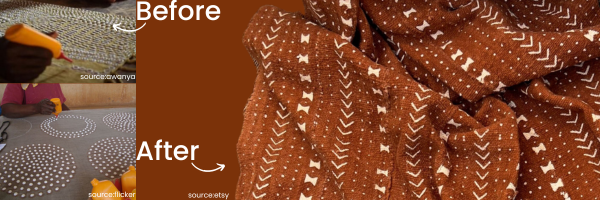Types of African Textiles
MALI – BOGOLANFINI

Handwoven textiles although in decline, continue to be produced because they are still useful in Malian daily lives. In households around the country, hand-built pots and hand-woven textiles continue to be used alongside factory-produced ceramics, plastic and metal cookware, and industrially milled cloth.
Mali has a long tradition of handweaving, and archaeologists have found cotton and wool textiles dating back to the first millennium.
Fulani, who raise sheep and goats, produce richly patterned wool blankets that families commission for marriages and that become cherished family heirlooms. Bogolanfini, a hand-painted mud-dyed cloth made by Bamana women, has enjoyed a spectacular revival in Mali in the last twenty years.
Today, this distinctive textile with its strong graphic appeal is not only worn in rural areas but also by fashionable urbanites throughout Mali.
The textile has found a market internationally because of its bold graphics and has been adopted as a symbol of African identity for people of African descent worldwide.

GHANA – KENTE & BOLGOTANGA
Kente Cloth is a hand-woven cloth created in Ghana for people of royalty, and has a deep rich history. The cloth is often woven out of cotton, rayon and silk.
There are over 350 patterns for Kente Cloths. The patterns are created during the hand weaving process and are determined by the manner in which the threads are intertwined.
Kente cloth was traditionally worn by royalty. However, in modern times they are worn by everyday people for special events such as weddings, naming ceremonies or funerals. Determining what kind of Kente cloth to wear depends on the event as the colors and weave patterns have meanings.
Kente Cloth Colors denote specific meanings. Below is a list of colors and their meanings:
• Blue – peace, togetherness, love and harmony
• Black – maturity, spiritual energy, mourning, funeral and passing rites
• Gold – high worth, richness, fertility, royalty, prosperity, monetary wealth
• Green – land, crops, vegetation, harvest, growth, spiritual growth and renewal
• Yellow – high worth, richness, fertility, royalty, prosperity, monetary wealth
• Grey – Healing rituals; cleansing rituals; symbolizes ash
• Pink – feminine; mildness and feminine qualities
• White – pureness, cleansing rites and festivals
• Maroon – mother earth and healing
• Red – death; funerals; mourning
• Purple – feminine; worn by girls and women
• Silver – peace and joy; referencing to the moon

ETHIOPIA SHEMMA
Weaving in Ethiopia has been a way of life for centuries; in the old era, all the traditional clothing was made from hand-woven textiles. Commonly, these outfits are white and prepared from locally grown cotton.
They also usually feature a decorative border called tibeb. Tibeb is a distinctive feature of Ethiopian textiles, is unlike other African fabrics. Tibeb is marked by highly elaborate patterns and bright colors. In modern times, weavers have incorporated tibeb into larger patterns for household products and personal accessories.
These products range from pillow covers, runners, table settings, and bed throws, to bags and shawls. Although the weaving techniques have not changed in centuries, the weaving patterns, colours, and threads have become more sophisticated.
In contemporary Ethiopia, weavers use intricate motifs with eye-catching hues that are beautiful and exotic. The threads are usually made of cotton, however, as the weaving has become more evolved, silk and rayon are widely used as well.
In today’s Ethiopia weavers are becoming highly skilled in their craft and their products are becoming sought after both within Ethiopia and outside the country.
DEMOCRATIC REPUBLIC OF CONGO – KUBA CLOTH
 Kuba textiles are unique in the Democratic Republic of Congo, for their elaboration and complexity of design and surface decoration.
Kuba textiles are unique in the Democratic Republic of Congo, for their elaboration and complexity of design and surface decoration.
Most textiles are a variation on rectangular or square pieces of woven palm leaf fiber enhanced by geometric designs executed in linear embroidery and other stitches, which are cut to form pile surfaces resembling velvet. Women are responsible for transforming raffia cloth into various forms of textiles, including ceremonial skirts, "velvet" tribute cloths, headdresses and basketry.
In Kuba culture, men are responsible for raffia palm cultivation and weaving of raffia cloth.
Several types of raffia cloth are produced for different purposes, the most common form of which is a plain woven cloth that is used as the foundation for decorated textile production.
Men produce the cloth on inclined, single-heddle looms and then use it to make their clothing and to supply foundation cloth to female members of their clan section. The cloth is coarse when it is first cut from the loom, so it is then pounded in a mortar, which softens it and renders it ready for the application of surface decoration, for which women are responsible. Production of the finished fabric involves four basic techniques: embroidery, applique, patchwork, and dyeing.




